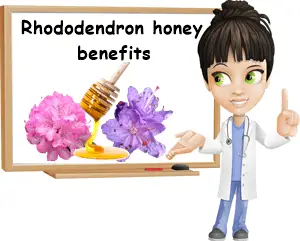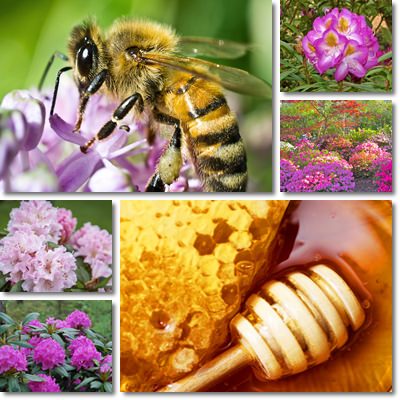There are roughly over 1,000 different varieties of rhododendron plants found throughout North America, Europe, Asia and Australia. The nectar of certain species is food source for bees and, together with the pollen of the flowers constitutes the raw material for the sought-after rhododendron honey variety. Not all species can lend themselves to being made into honey, but those that do hold several unique properties. Rhododendron honey holds both beneficial health effects and health risks, depending primarily on the plant species employed for honey production and on the amount of honey consumed.
What species is rhododendron honey made from? Generally, bees and bumblebees use the nectar and pollen of most flowering plants they have access to, so rhododendron honey from different parts of the world can be made from different varieties of the same species of flowering plant. Rhododendron honey from North America can be made from different species of rhododendron than the same honey variety from Nepal or Turkey, with the mention that not all flower varieties of the species are suitable for honey-making. Moreover, the honey can be exclusively rhododendron or contain nectar and pollen from other species flowering at the same time and in roughly the same area where the bees collect their food.

What does rhododendron honey look like? Generally, rhododendron honey is known to have a distinct golden yellow color with orange reflexes. However, considering the wide variety of rhododendron species bees from around the world can take their nectar and pollen from, the honey may vary in color and be, for example, a brownish-yellow or mustard-colored with rich brown undertones. Color may be altered by the presence of other floral species within the honey and changes with time. For example, as it crystallizes, it tends to lose its pigment and take on a duller beige color, sometimes with a brownish tint.
What does rhododendron honey taste and smell like? This particular variety of honey generally has a faint, sweet honey and herbal fragrance. As for its taste, it has a certain sweetness to it, but not very long-lasting, and a slight bitter aftertaste with watermelon rind notes. Overall, rhododendron honey has a sweet, floral, herbal taste with a refreshing bitter aroma.
What is mad honey disease? Mad honey disease is the name given to intoxication caused by rhododendron honey consumption. Not all varieties of the honey cause such side effects because not all varieties of the plant contain grayanotoxins, the compounds responsible for these properties. Two species in particular, the common pontic rhododendron (Rhododendron ponticum) with purple-violet flowers and the yellow rhododendron (Rhododendron luteum), have been found to contain these compounds and lend the resulting honey several potentially harmful effects, making consumption of moderately high and even small amounts risky and potentially unsafe.
How does rhododendron honey intoxication occur? When you eat too much of the honey. Typically, many of those who have suffered from mad honey disease after eating rhododendron honey have consumed too much of it, with the hopes of amplifying its mild therapeutic properties. The honey is said to help with gastrointestinal problems such as ulcers or gastritis and be a natural aphrodisiac. As a result, some people might believe that eating more of it can amplify its mild properties. Unfortunately, because of the presence of grayanotoxins in certain varieties of the honey, mild to severe symptoms of intoxication may occur.

What is it good for?
What are the benefits of rhododendron honey? Like all honey types, rhododendron too has its benefits. The following are the most notable beneficial effects of the honey variety:
1) Antibacterial action. All honeys naturally contain an antibacterial called hydrogen peroxide. This compound is made from glucose from honey and an enzyme secreted by bees called glucose oxidase. The hydrogen peroxide content in the honey together with its low moisture content that doesn’t favor bacterial growth and acidic pH with additional antimicrobial effects are responsible for the antibacterial action of rhododendron honey. Currently, honey-based, sterile wound dressings are being developed and are believed to favor faster wound healing due to honey’s antimicrobial action.
2) Tonic, energizing effect. Rhododendron honey is a source of essential nutrients such as amino acids and proteins, trace amounts of vitamins and dietary minerals as well as antioxidant compounds and natural sugars, all of which have a tonic effect and help prevent and manage hypoglycemia, restoring good energy levels and vitality.
3) Contributes to skin health. Honey in general can be used topically as a natural skin mask, provided we are not allergic to it. I apply a layer of raw honey on the face, let it sit for 20 minutes, then wash it off with lukewarm water. I find it helps remove blackheads, prevent acne breakouts and tightens skin due to its mild astringent effect. In my experience, light-colored honeys also help even out skin tone and give a natural glow to my skin.
4) Soothing effect. Due to its thick consistency, honey in general is great for inflamed or irritated mucosas, hence its use for treating a sore throat or gastritis. Taking a tablespoon of raw honey can help reduce sore throat discomfort and bacterial load in case of a respiratory infection, whilst eating a tablespoon on an empty stomach is said to allow the stomach lining to heal, potentially helping improve gastritis. However, you are not supposed to eat or drink anything for an hour or more to allow the honey to exert its effects.
But because of its side effects, the varieties of rhododendron honey containing grayanotoxins might not be the best choice for soothing upset mucous membranes. Other varieties of honey such as acacia, cherry or manuka are far healthier, provided, of course, you are not allergic to them.
Honey disease symptoms
What are the symptoms of rhododendron honey intoxication? Typically, people who eat too much of the honey experience mild to severe side effects, but depending on the area where the honey is produced, even a taste of it can leave you lightheaded, dizzy and with a low heart rate. This is because the two main varieties of the plant that are richest in grayanotoxins are found concentrated in certain parts of the world such as the eastern regions of the Black Sea, notably Turkey. This is the reason for all those cases of Turkish rhododendron honey intoxication.
Generally, signs and symptoms of mad honey disease caused by rhododendron honey intoxication disappear over the course of a couple of days and include:
1) Sudden, excessive perspiration.
2) Muscle weakness.
3) Abnormally low blood pressure.
4) Diarrhea (the honey can have laxative properties).
5) Low heart rate (less than 60 heartbeats per minute).
6) Lightheadedness, dizziness, loss of balance.
7) Numbness, burning sensation or tingling in the corners of the mouth or hands or feet.
8) In rare cases, ingesting significant amounts of the honey from certain varieties from Turkey can lead to heart attack.
Lastly, like all honey varieties, rhododendron too can cause allergic reactions. Having an allergy to honey in general, to the pollen of rhododendron flowers which is incidentally added to the honey because it rubs off bees when they collect nectar, or multiple pollen allergies which increase one’s risk of being allergic to plant pollen in general and everything containing it means we are likely allergic to rhododendron honey too, in which case consumption is to be avoided.
Conclusion
Aside from its more unique properties that make the honey from certain varieties of the plant potentially unsafe for consumption in certain amounts, rhododendron honey exhibits antibacterial, astringent and tonic effects and can help manage hypoglycemia and acne breakouts as well as improve overall skin health. However, it is important to educate ourselves about the origin of the honey so the source of the nectar is a rhododendron species that is free of toxins and safe for consumption.
